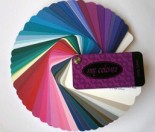6 steps to fabulous wardrobe planning, it all sounds so wonderful doesn’t it? A great personal style filling you with energy and confidence!
But how on earth do you actually transform your current cupboard-of-doom into your fabulous dream wardrobe?
I can relate to this question very well. Whenever I read an article on healthy eating, or speak to any of my foodie friends, I get excited about trying out a new food or meal idea. But in reality, if it’s not in the freezer section of the supermarket, I wouldn’t know where to start finding the ingredients; let alone storing them, preparing them and serving them in an appetising arrangement.
I need a patient friend to actually sit down with me and help me write out a plan of what I’m going to cook when and how, and where the best places are to find all the ingredients
Everything is easier if you’ve thought ahead and you’ve got a plan.
With that in mind, I’d love you to imagine yourself sitting at the comfort of your kitchen table, with your ideas on colours, shapes and styles in front of you (magazine cut-outs, Pinterest mood board… however you collect your inspiration).
Now, imagine me sitting beside you with pen and paper saying, ‘this looks fantastic! Let’s make a plan so we can make it happen’.
6 steps to Fabulous Wardrobe Planning
Step 1: Map your Lifestyle
First step in working out what you need in your wardrobe is to work out the practical stuff: what you do in your clothes, and what you need their help to accomplish (as Mark Twain so eloquently put it: “naked people have very little influence on history”).
I’m a big fan of mind maps.
If you’re more of a lists person that’s perfectly fine too. I suggest the following headings: Home, Work (whatever your definition), Hobbies, and Social.
Then have a go at filling in all the activities you do around those areas of your life in an average day, month, or year. Include things you’re planning in the near future too (you may like to put these in with a different colour pen).
These planed activities could be a little vague, especially if your plans include a major lifestyle shift such as having your first baby, or returning to work, but picture your ideal scenario (if you plan for it, you’re more likely to find opportunities to make it happen).
As an example, here’s a mind map I created for my own lifestyle activities a couple of years ago:
Step 2: Create your own Dress Code
Dress codes needn’t be just for businesses and fancy dress parties.
This isn’t about conforming to strict standards telling us what we cannot wear. Dress codes are simply a way of thinking about who you are with in each situation, what impression you want to give, and how you want to feel.
You can name each category whatever you like, but to keep it simple you can stick with the usual: ‘casual’, ‘smart casual’, ‘professional’, ‘formal’.
I suggest you pick a different coloured highlighter for each dress code, and go over your mind map, highlighting each separate activity in the colour you feel appropriate. Keep in mind, this is your life and your style – there is no way of doing it wrong!
Choose your colour palette
Next, choose a colour palette that suits you. This doesn’t mean you have to stick to just a few colours, but having a general idea of what colours you like can make shopping and outfit planning much easier. Think about the colours that make you feel happy and confident. You might want to include some neutral colours like black, white, and grey, as well as some accent colours that add a pop of fun to your outfits. Remember, your colour palette should reflect your personality and make you feel good.
Identify your go-to outfits
Now, identify your go-to outfits. These are the clothes that you can always rely on to make you feel good and look put together. For me, it’s a pair of well-fitting jeans and a comfy t-shirt. Think about the outfits you reach for when you’re in a rush or when you want to feel your best. Having a few go-to outfits can make getting dressed each day so much easier.
Consider your body shape
When creating your dress code, it’s important to consider your body shape. Different styles and cuts of clothing can look very different on different body shapes, so it’s important to find what works best for you. Don’t be afraid to try on different styles and see what makes you feel the most comfortable and confident. Remember, the goal is to create a wardrobe that makes you feel good about yourself.
Set your dress code guidelines
Finally, set your dress code guidelines to help you stay true to your personal style and make getting dressed each day a breeze. Your guidelines might include things like always having a few go-to clothes ready, sticking to your chosen colour palette, and only buying clothes that make you feel good. Having these guidelines in place can help you stay focused and avoid getting overwhelmed by the latest trends.
Step 3: Wardrobe Proportions
One of the major causes of Wardrobe-Full-of-Clothes-But-Nothing-to-Wear Syndrome is that 80% of our wardrobes are dedicated to things we only do 20% of our time. So let’s dive into how you can balance your wardrobe proportions effectively so you can quickly decide on what to wear.
Analyse your wardrobe
Take a good look at what you already have. This is where a wardrobe inventory comes in handy. List down all your clothing items, from tops and trousers to dresses and sweaters. This will give you a clear picture of what you own and help you identify any gaps or excesses.
Categorise your clothing
Once you have your inventory, start categorising your clothes. You can do this by by dress code (e.g., casual, work, special events). This step is essential for understanding your wardrobe needs and ensuring you have the right mix of items for different aspects of your life.
Balance your wardrobe
Now that you have your categories, it’s time to balance them. A well-planned wardrobe should have a good mix of different types of clothing. For instance, if you find that you have 20 pairs of trousers but only 5 tops, it’s time to even things out. Aim for a balanced ratio that suits your lifestyle and daily activities.
Prioritise versatile pieces
One of the keys to a functional wardrobe is versatility. Prioritise items that can be mixed and matched easily. Think about your core wardrobe pieces—those items that you can wear in multiple ways. This will not only save you time but also make your wardrobe more efficient.
Plan for different seasons
Don’t forget to consider the different seasons when planning your wardrobe. Make sure you have appropriate clothing for each season, whether it’s lightweight dresses for summer or cosy sweaters for winter. This will ensure that you’re always prepared, no matter the weather.
Remember, a well-balanced wardrobe is not about having a lot of clothes, but about having the right clothes that meet your needs and make you feel fabulous every day.
By following these steps, you’ll be well on your way to achieving the ideal wardrobe proportions.
Step 4: Key Looks
Identify your signature style
As mums, we often get caught up in the hustle and bustle of daily life, and our personal style can take a backseat. But identifying your signature style is like finding that missing piece of a puzzle. It’s about knowing what makes you feel confident and comfortable. Think about the clothes that make you feel fabulous, whether it’s a pair of well-fitted jeans or a flowy dress. Your signature style should reflect your taste and personality.
Create a mood board
Creating a mood board is a fun and creative way to visualise your style. You can use platforms like Pinterest or even good old-fashioned magazines. Cut out pictures of clothing tems, colours, and accessories that you love. This will help you see patterns in your taste and give you a clearer idea of your key looks. Don’t forget to share your mood board on social media to get feedback from friends!
Experiment with combinations
Once you have a clear idea of your signature style, it’s time to play around with different combinations. Mix and match items from your wardrobe and you might be surprised at how many new looks you can create with the clothes you already have. This is also a great way to identify any gaps in your wardrobe. Maybe you need a new pair of shoes or a versatile jacket to complete your looks.
Once you have at least one outfit for each dress code, you’ll start to see just how you can relate your style and colour preferences to your lifestyle.
With any luck, you’ll find quite a lot of these items cross over into several areas. You get extra points for these items.
Invest in statement pieces
Every wardrobe needs a few statement pieces that can elevate any outfit. These are the items that make you feel special and stand out. It could be a bold necklace, a stylish handbag, or a pair of killer heels. Investing in statement pieces doesn’t mean you have to break the bank. Look for quality items that you love and that will last. Remember, it’s better to have a few great pieces than a closet full of things you never wear.
Refine your key looks
Finally, take some time to refine your key looks. This means going through your wardrobe and making sure everything fits well and is in good condition. Get rid of anything that doesn’t make you feel fabulous. It’s also a good idea to plan your outfits for different occasions, whether it’s a casual day out with the kids or a special event. Having a few go-to clothing items ready will save you time and stress.
Remember, your wardrobe should make your life easier, not harder. Take the time to plan and refine your key looks, and you’ll always have something fabulous to wear.
Step 5: Capsule Wardrobes
To help you maximise the versatility of the items you plan to look for, a plan of a capsule wardrobe can help immensely.
Understand the capsule concept
The idea behind a capsule wardrobe is to pare down your clothing to a core set of pieces that you love and that work well together. This means focusing on quality over quantity and choosing items that can be worn in various combinations. Think of it as a curated collection of your favourite clothes and accessories that reflect your personal style.
Select your core items
When building your capsule wardrobe, start with the essentials. These are the pieces that form the foundation of your wardrobe and can be mixed and matched with other items. These core pieces should be in base colours that can easily be paired with other items in your wardrobe.
Mix and match outfits
One of the best things about a capsule wardrobe is the ability to create a variety of outfits from a limited number of pieces. By mixing and matching your core items, you can come up with different looks for different occasions. For example, you can pair a basic top with jeans for a casual day out, or dress it up with a blazer and accessories for a more polished look.
Incorporate accessories
Accessories play a crucial role in a capsule wardrobe. They can transform a simple outfit into something special and add a personal touch to your look. Consider adding a few key accessories to your collection, such as:
- A statement necklace
- A classic handbag
- A versatile scarf
- A pair of stylish sunglasses
These items can help you change up your outfits and keep your wardrobe feeling fresh.
Review and adjust regularly
A capsule wardrobe is not a one-time project; it’s an ongoing process. As your lifestyle and needs change, so should your wardrobe. Take the time to review your capsule wardrobe regularly and make adjustments as needed. This might mean swapping out items that no longer fit or adding new pieces that better suit your current style.
With any luck, you’ll find quite a lot of these items cross over into several areas. You get extra points for these items.
Remember, the goal of a capsule wardrobe is to make your life easier and more enjoyable. By focusing on versatile pieces and keeping your wardrobe organised, you can spend less time worrying about what to wear and more time enjoying the things that matter most.
Step 6: Budget
Why does this word always creep into anything related to ‘planning’? I guess it’s because it’s important. The main reason I come across for people who’ve never budgeted for their own clothing is that they’re waiting until they have more disposable income over and above their current needs.
Again I go back to Mark Twain – naked people don’t get very far. Consider your wardrobe an essential expense and budget for it. It will help immensely knowing you have even $1 a week that’s solely for the purpose of establishing and maintaining your wardrobe, to help you do the things that are important to you.
Like cooking, parenting, and anything else worthwhile, wardrobe planning is something that’s ongoing. Our lifestyles and personal styles are dynamic. Being able to review and tweak our plan as we go, is the way to ensure we continue to find our wardrobe interesting and engaging.
Congratulations, you now know the 6 steps to fabulous wardrobe planning! If you’ve been keeping up with my previous articles, by now you’ll be feeling excited about getting to wear glorious colours, flattering styles and knowing how to put your unique twist on outfits.










This is very helpful
It was helpful and interesting
Glad you found some value in it! — Jarrod
This is nice
Thanks, it’s a really good article actually. But, I must confess, looks nothing like our own wardrobe 🙂